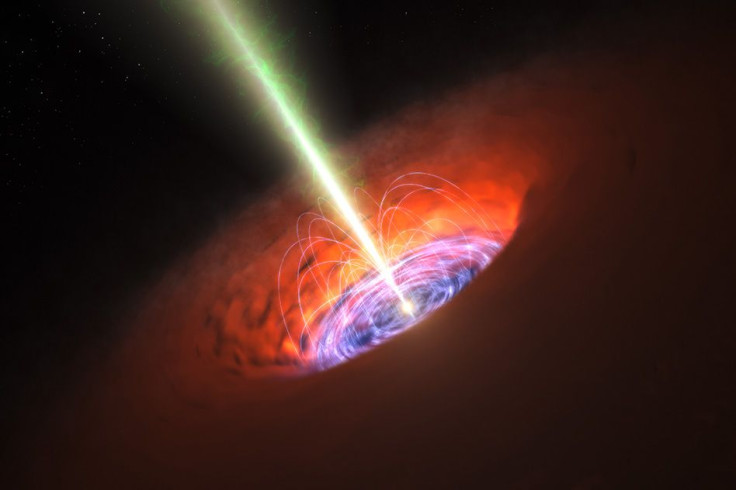Supermassive Black Hole Shoots Out Jet While Gobbling Up A Star

Black holes are immensely powerful stellar objects that can destroy smaller objects that travel close. When a star passes close to a black hole, it creates a cosmic phenomenon called a tidal disruption event. The black hole’s gravitational pull creates tidal forces on the star, not unlike the tidal forces the moon generates on Earth. However, such is the power of a black hole’s gravitational pull that it can completely rip apart the star passing it by.
Scientists from MIT and Johns Hopkins University have now detected radio signals from such a tidal disruption event. Scientists believe these are radio “echoes” of a massive jet of energy being emitted from a supermassive black hole, as it gobbles up stellar material.
According to Dheeraj Pasham, a postdoc in MIT’s Kavli Institute for Astrophysics and Space Research, the jet shot out from the black hole appears to be controlled by the rate at which the black hole is feeding on the star.
“This is telling us the black hole feeding rate is controlling the strength of the jet it produces,” Pasham said in a statement. “A well-fed black hole produces a strong jet, while a malnourished black hole produces a weak jet or no jet at all. This is the first time we’ve seen a jet that’s controlled by a feeding supermassive black hole.”
Scientists are currently still unclear about what causes radio emissions during a tidal disruption flare. One theory suggests that in the moments after the star’s explosion, a shockwave is produced that energizes the surrounding plasma particles, which in turn emits radio waves.
However, the new study, published in the Astrophysical Journal, differs from this theory. “What we found basically challenges this paradigm,” Pasham said.
The researchers looked at data recorded from a tidal disruption flare in 2014 that occurred around 300 million light years away. When studying the radio data gathered from the event, researchers found a startling 90 percent resemblance in patterns they had previously observed in X-ray data of the same event.
Scientists found that the same fluctuations that appeared in the X-ray spectrum also appeared 13 days later in the radio data. The data allowed researchers to calculate the size of the X-ray emitting region, which was found to be around 25 times bigger than the sun. Researchers also discovered that the size of the radio-emitting regions was around 400,000 times the radius of the sun.
“The only way that coupling can happen is if there is a physical process that is somehow connecting the X-ray-producing accretion flow with the radio-producing region,” Pasham said. “It’s not a coincidence that this is happening. Clearly there’s a causal connection between this small region producing X-rays, and this big region producing radio waves.”
According to the new study, the radio waves were emitted by a high-energy jet stream that was shot out from the black hole, soon after it began absorbing material from the star. Researchers also believe that most of the radio waves were quickly gobbled up by other electrons, since the area where the radio waves first formed was so incredibly densely packed with electrons.
Researchers suggest that they were able to detect the radio waves only when the electrons travelled down the jet stream, indicating that the jet’s power must be controlled by the black hole’s accretion rate – the speed at which the black hole devours the star.
“If the rate at which the black hole is feeding is proportional to the rate at which it’s pumping out energy, and if that really works for every black hole, it’s a simple prescription you can use in simulations of galaxy evolution,” Pasham said. “So this is hinting toward some bigger picture.”
The new research could help scientists further understand the role black holes play in regulating the growth of galaxies and could also help us better understand galaxy evolution.
© Copyright IBTimes 2025. All rights reserved.





















